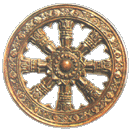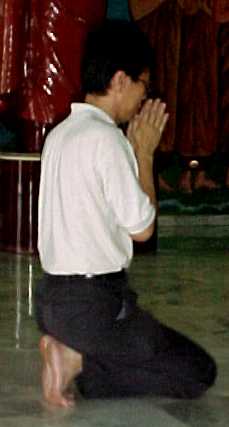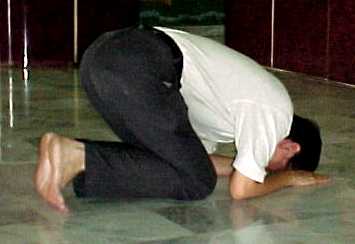in commemoration of the occasion of his 80th birthday (1999)

This booklet aims to assist new Buddhist students who are unfamiliar with some Pali words often used in the study of Buddhism. As the title of this booklet suggests, we encourage the learning and usage of the Pali words by learning one word each day. Its serves as a dictionary as well as a glossary of terms for your reference. We had selected these basic Pali words as a start to a deeper understanding of the Buddha-dhamma. We strongly recommend the readers to further their study and research into the Pali Ti-pitaka.
May this booklet enhance and promote all of you to continue to track the path of our Master – the Buddha.
|
in commemoration of the occasion of his 80th birthday (1999) |
 |
| A | B | C | D | E | F | G | H | I | J | K | L | M |
| N | O | P | Q | R | S | T | U | V | W | X | Y | Z |
Abhaya Dana – Giving of non-fear, trust, warmness, tolerance. In the consideration of the Gifts, when one gives space and allowance for others to move and time to think or by not be-little their capabilities or weaknesses one is considered as giving non-fear. In Anguttara Nikaya, book of the three, verse 172, the Buddha said that one should give in such that the donee does not feel humiliated, belittled or hurt.
One should give with due consideration and respect and made the donee feel a warm welcome and like coming again. Personally involved in the act of giving such as giving with our own bare hands and promoting the rapport through our caring, willingness and concern attitudes with the donees will definitely enhance the quality of our abhaya-dana. What more if we were to give things that are good, choice, useful and appropriate. And not what is only fit to be thrown away.
| Different from Vow, determination is based on wisdom, compassion
and selflessness, and not promises that we have to pay back later. It is
also the key virtue required to achieve our spiritual path. Through a
strong determination one perfects his paramis. Buddhists like to make
their aspiration at the Bodhi Tree.
Just like the
Bodhisatta Gotama did before He attained His Enlightenment, we make our
adhittana by reciting, “By the power of the merits that I have
accumulated, may I …” Whenever one does a good deed, such as dana, one
should make an aspiration, |
 |
The anatta doctrine is one of the most important teachings of the Buddha. It is also the distinctive feature in Buddhism that can't be found in other major religions. Yet it is the most misunderstood, most misinterpreted and most distorted of all His teachings. There is nothing we can call an inner core, which is eternal and blissful. There is also nothing we can call upon to exercise authority over the nature of things.
There is no doer apart from doing, and no one, which is omnipotent because everything is at the mercy of the constant creation and dissolution of conditioned things. We are a compound of 5 khandas (aggregates) –– which are interacting and dependent upon each other and make up the personality. No director, no doer, no experiencer, and no essence can be found. Therefore there is no “I”, “mine”, “my-self”, etc. But the body, feeling, perception, mental formation and consciousness phenomena held together that we experience the “I”.
It is from the fact of impermanence that, the other two characteristics; dukkha (suffering) and anatta (non-self), are derived. Whatever arises and passes away is anicca. What ever is anicca is suffering and what ever is suffering is of non-self. Anicca is the natural law of the universe. Everything, be it living or non-living, mind or matter are subjected to change. In the law of Kamma (cause and effect), everything is the creation of their preceding causes and is in turn a cause for the after-effects.
Therefore, what is in existence, is an ever-changing flux. It is not anicca that causes suffering but the clinging and craving for the permanent everlasting that causes suffering. The last word of the Buddha was,“ All component things are subject to change, Strive on with diligence.”
| Buddha The Enlightened One, the Perfect One, the Holy One, the Omniscient In order to attain
Buddhahood, one must perfect oneself in the ten
Paramis Nibbana can be attained through one of the following three Yanas (vehicles) : |
 |
| 1.
Samma-Sam-Buddha (Fully Enlightened One) |
One who aspires to
become a Buddha must first make a firm resolution (Boddhisatta Vow) in the
presence of a Buddha. Once he is proclaimed to be a Buddha in future, he will have to practice the 10 paramis with self sacrificing spirit to serve the suffering humanity. |
| 2. Pacceka Buddha | He who attained
enlightenment without any spiritual assistance.
He does not possess the faculty to enlighten others. |
| 3. Savaka Buddha (Arahant) | He who has
completely eradicated all the defilement including the 10 fetters with the
guidance from the Buddha teachings. He is capable of rendering the spiritual assistance to others for their liberation. |

Dhamma Cakka Pavatthana
Sutta (The discourse to set in motion the Wheel of Dhamma) teaches us the Four
Noble Truths. It forms the basis on which the system of Buddhist
philosophy was founded.
1. The Noble Truth of Suffering
(Dukkha)
2. The Noble Truth of the Cause (Samudaya) of Suffering – that is
Craving (Tanha)
3. The Noble Truth of the Cessation (nirodha) of
Suffering – the attainment of the Non-rebirth (Nibbana)
4. The Noble Truth of
the Path Leading to the Cessation of Suffering – Ariya Atthagika
Magga
(the Noble Eight-fold Path)
The first Truth is to be comprehended while the second one is to be eradicated. The third one is to be realized and the fourth one is to be developed. The Noble Eight-fold Path also known as the Middle Way (Majjhima Patipada) is the method of avoiding the two extremes:
Self-mortification that weakens one's intellect andIt consists of the eight Right factors folded together for one to proceed in his journey of Truth and Liberation.
Self-indulgence that retards one's moral progress.

It is the first step towards eliminating the defilement of greed, hatred and delusion for every act of giving is an act of loving kindness (metta) and compassion (karuna). Dana should be performed with the purpose of removing greed with samma-ditthi (right understanding.) The three considerations of a Giver are:-
1. to feel happy on his wholesome deed before, during and after the danaAlthough one may make his worldly aspiration such as good health, wealth and happiness, it must be made with the intention to support one's spiritual growth. Good health will enable one to practice meditation; wealth will enable one to continue doing dana and birth in the happy realm (loka) where Dhamma exists.
2. to have saddha (faith or confidence) in the Law of Kamma
– Dana performed with right understanding will bare good results that is
accompanied by panna (wisdom)
3. making resolution (Adhitthana) to attain Nibbana.
It comes in many names and faces such as dislike, grudge, enmity, aversion, etc.
It also appears in a subtle form as a retaliation of a result, upset over the uncertainty in life, resentment … And in disguise, dosa is boredom, indecisiveness, frustration, envy, helplessness, ignorance, etc. Anger is harbored easily in the heart especially those words that are not fit to one's ears/ego.
Anger is prompted by a cause, be it a mosquito bite or a sight of disgust. There are two causes:
1. The repulsive/negative nature of the object.The manner of overcoming anger includes loving-kindness (metta) in the heart, compassion (karuna), a sense of equanimity (upekkha) and right understanding of the Law of Kamma. And if all the 4 failed, avoid the situation.Things are changing all the time. They are not permanent. So are our thoughts, feelings and perceptions. If there is no dark, there is no bright.2. The unsystematic attention towards that repulsive nature.A fool views the bright side with greediness and the dark with anger, while the wise views the bright with loving-kindness and the dark with detachment.
Birth (Jati) is suffering, so is aging or decay (Jara), sickness (vyadhi), death (marana), and disassociation from loved ones and not getting what one want. In short, the five aggregates (khandas) of grasping are suffering. The influence of sensuality is so tempting that we believe in the “Self”. And the more we attach to it the more suffering it will be.
The attachment to sense objects and not knowing or ignorance (avijja) that they are impermanence (anicca) lies the cause of dukkha, which is manifested as craving (tanha). The three types of dukkha are :
1. suffering of the mind & body in the ordinary sense such as pain, discomfort, etc.
2. suffering of aggregates due to the rising and falling away of the momentary phase of existence.
3. Dukkha caused by changes or transience.
This is one of the virtues in the Buddha-dhamma. The Buddha invites us to come and see, to examine, to verify, test and to experience the results of His teachings. The learning of the Buddha-dhamma demands no blind faith. There are no commandments or rules to penalize its followers who do not want to believe in it.
The only way for one to realize the Truth is from one's free will of acquiring the knowledge and practice. By forcing someone to accept certain teachings which they are not ready to receive will not benefit them in their spiritual progress. The Buddha is not afraid to let His teachings be tested, for realization only come from the practice of His teachings. The Buddha-dhamma is also Svakkhato (well taught), sanditthiko (to be self-realized), akaliko (with immediate result), opanayiko (capable of being entered upon), paccattam veditabbo vinnuhiti (to be attained by the wise each for himself).
A work of the Theravada (Doctrines of the Elders) Canon, contains a collection of 547 stories or previous existence of Buddha Gotama. Of great value in folklore and Buddhist mythology as the background of moral tales. Each Jataka has its own moral story as it shows how the Bodhisatta practiced and developed the virtues required for the attainment of Buddhahood.
The Jataka Tales are accounts of the Buddha's previous lives, originally told by the Buddha to His disciples. In His previous life the Buddha appeared in many forms such as animals, human beings, nagas (dragons) and devas (heavenly beings). The Jatakas emphasize the selflessness of compassion, love and kindness and the beauty of virtuous action.
The Jatakas teach that we are fully responsible for our actions, and that what we think and do affects the quality of our lives. This basic principle is known as Kamma.
The Law of Kamma – the law of cause and effect, action and the appropriate result of action. All our actions can be classified into three: namely thought (mental action), speech (verbal action) and body (physical action). Therefore in order for these action to become kamma, they must be associated with cetana (volition) or intention. Thus kamma can be kusala (wholesome) or akusala (unwholesome).
Kamma is not a doctrine of pre-determination. The past influences the present but does not dominate it. The past and present influence the future and etc. The result of Kamma is called Vipaka (consequence) or phala (fruition). And this leads to another best known fundamental teachings of the Buddha – the doctrine of Rebirth.
Kamma is the chief causes for all the inequalities in the world yet not everything is due to their past actions. The simple explanation on how Kamma works is: good beget good; bad beget bad; good and bad beget good and bad; neither good nor bad beget neither good nor bad.
Karuna should be practiced with wisdom (panna). It is a thought of peace and harmlessness meant to reduce the pain of other fellow beings that are not so fortunate compared to oneself. At the height of this practice, one might even go to the extent of sacrificing one’s own life to alleviate the suffering of others. It has the characteristic of a loving mother whose thought; words and deeds always tend to release the distress of her sick child.
The purpose of Karuna is to help eliminate the element of cruelty. The cultivation of Karuna is not just talking but action counts. Compassion is the motivating factor for the making of a Bodhisatta Vow. One must be able to differentiate the feeling of emotionally upset by the suffering of others as pity or grief and not karuna. Karuna like the other three virtues in the Brahma Viharas, is a positive mental quality.
Every year the Buddhist monks will observe their vassa (rainy season retreat) for about 3 months. During this retreat, the monks go into intensive meditation practice. At the end of their vassa, they are allowed to receive their new robe or a piece of cloth for making a robe from the lay devotees. The Kathina Robe is made of several pieces of cloth sewn together in the pattern of paddy field and looks like a rag robe.
The Kathina Ceremony has to be celebrated within a month after the vassa in the Sima Hall in the Monastery or Temple where they dwelt during the vassa. There will be only one Kathina Robe offered to the monk who spent the retreat according to the rules (selected by the community of monks in that Temple). The offering of the Kathina Robe is considered as a very meritorious deed because the merit accrued is as “hard” (Kathina) as a diamond. The donors could go anywhere without fear, eat any things without danger, their belongings are safe from flood, fire and thieves; they are liable to receive many clothes and own many possessions.
It is the enduring of suffering caused by others or the forbearance of other’s wrong. A person who practices patience will not allow the thought of revenge or retaliation to enter his mind when he is tested with anger. Instead he tries to put the wrong doer on the path of Righteousness and extends to him thoughts of love and compassion. To practice khanti, one should be able to control one’s temper through the right understanding of the real nature of life.
By losing our temper, we are not only losing one’s peace, happiness, health, beauty, friendship and popularity, but also the ability to distinguish the good from the bad and the right from the wrong. The characteristic of khanti is acceptance and its function is to endure the desirable and the undesirable things. While the manifestation of khanti is a non-opposition character, the quality to achieve it is wisdom – the ability to see things as they really are. By understanding the three characteristics of life (anicca, dukkha, and anatta) and the Law of Kamma, one will be able to manage one’s senses.
A wholesome deed is an act:
1. which does not harm either the doer or othersDasa Kusala Kamma (10 meritorious deeds)
2. praised and approved by the wise, and
3. when performed, it conduces to the benefit and happiness of both oneself and others
1. Dana (generosity)Akusala (unwholesome) Kamma includes killing, stealing, unchastely, lying, slandering, harsh speech, frivolous talk, covetousness, ill will and false view.
2. Sila (virtue)
3. Bhavana (mental culture – meditation)
4. Apacayana (reverence, act of respect)
5. Veyyavacca (service, rendering help)
6. Pattidana (transference of merit)
7. Pattanumodana (rejoicing in others’ merit)
8. Dhammasavana (listening to the doctrine)
9. Dhammadesana (teaching the doctrine)
10. Ditthijjukamma (straightening one’s views) forming correct views, establishing right understanding.
Being the root cause of evil, it transforms itself into many faces. Hoarding – holding on without letting go, obsession with the material gain, miserliness, and yearning – desire to possess what others have, clinging to desirable object of sense, etc. In a subtle form, thriftiness – a kind of reluctant to waste things appeared to have the element of lobha in its’ root. While the stronger one turn itself into grasping onto the mind object as sense desire. It has the function of “to stick” and the manifestation of lobha is not giving up.
The proximate cause is seeing the enjoyment in things that lead to bondage. Lobha can turn easily into dosa when one failed to get the desirable object and thus create all the possible akusala kamma (unwholesome deeds). One need to learn how to be contented (santosa) and letting go our sensual lust (kama). One needs to watch out that clinging to the rules and ritual will hindered one’s spiritual progress.

There are 31 states of existence onto which beings are born, according to their kamma. Basically they are divided into 3 groups or bhava (becoming or state of existence)
1. Kamabhava (sensual world, plane of desire)
a) The 4 Apaya-bhumi (plane of misery) or lower world: Niraya (hells), Tiracchana-yoni2. Rupabhava (plane of form) or Brahma-loka.
(animal realm), Peta-yoni (hungry ghosts realm) and Asurayoni (demon world).
b) 7 Kamasugati-bhumi (happy states) : Manussa (human realm); Catummaharajika, Tavatimsa,
Yama, Tusita, Nimmanarati, Paranimmitavasavatti heavens (deva realms)
Consist of 16 categories of distinction depending on the state and intensity of the four stages of jhana
(a state of serene contemplation).3. Arupabhava (formless plane) In the 4 highest realms there is only mind and no physical form.
It is also a warm and friendly feeling of good will and concern for the well being and happiness of one self and others. It is a practice of positive mental qualities to overcome anger (dosa), ill will, hatred and aversion. Just as a mother will protect her only child, even at the risk of her life, even so one should cultivate boundless love towards all living beings.
Metta should be radiated in equal measure towards oneself, friends, enemies and neutral regardless of their strengths, size, seen or unseen, those dwelling far or near. The culmination of this metta is the identification of oneself with all beings, making no difference between oneself and others thus the so-called “I” does not exist.
Metta is neither passionate love (pema) nor desire to possess (want). It is above normal human love of caring, trust and respect. It is universal and limitless in scope. Metta possesses a magnetic power than can produce a good influence on others even at a distance.
Kalyana Mitta– Spiritual friends and friendship. The purpose of friendship is to grow mutually, to improve spiritually in faith (saddha), generosity (caga), virtue (sila), knowledge and wisdom (panna). It is the forerunner of goodness in life such as happiness, wealth, opportunity, etc. It is the supporting condition for the growth of all goodness.
A Real Friend is a friend
who helps when in need, who shares the same weal and woes with you, who gives
good counsel and who sympathizes.
While an Enemy in
Disguise of a Friend is one who associates for gain
(a taker), who render
lips services (a talker), who flatter (a flatterer) and who brings ruins to your
wealth (a spender).
The qualities of a Good
friend are he who..
1. gives what is hard to give
(dana)
2. does what is hard to do
3. hears what is hard to hear or
bear
4. confess (shares) his own secret with you
5. keeps others’
secrets
6. in need, forsake one not
7. despises not when one is in
ruin.
Its chief characteristic is happy acquiescence in others’ prosperity and success. It is one of the four Sublime Abodes of Conduct (Brahma Viharas). The other three are Metta, Karuna and Upekkha. By rejoicing in the skillful action and merits of others, one tends to eradicate jealousy (issa) which will lead to unwholesome deeds through action, speech and thoughts. The practice of mudita demands great personal effort and strong will power.
The development of mudita requires systematic evaluation, Right understanding and moderation. Hence, one should always be mindful of its near enemy, which is laughter, merriment, excitableness and exhilaration, while its far enemy is jealousy and envy. Mudita is like a mother's joy over the success and youthfulness of her child. A Buddhist practicing mudita will happily say, “Sadhu! Sadhu! Sadhu!” which mean well done or excellent, to rejoice in the merits of others.
It forms the basic Buddhist moral code of conduct with the objective of guarding the sense doors. I undertake to observe the precept to abstain …
1. from destroying living beings (panatipata)With the cultivation of loving kindness and compassion, it helps in controlling the passion of hate and anger in us.2. from taking what is not given (adinnadana)Avoiding stealing, robbing, swindling or even taking more than what is given, we exercises self control over the desire to possess things belonging to others. In other words, one is practicing generosity, sincerity and developing trustworthy.3. from sexual misconduct (kamesu-micchacara)By curbing our lust for excessive sensual pleasure such as adultery, we show respect for the safety and integrity of others and cultivate contentment.4. from false speech (musavada)Lying or deceiving (telling less that it should) are the negative values of honesty. One should avoid cheating, exaggeration and slandering to gain wealth, fame and power.5. from drugs and liquor (sura)This is not a way of escapism from reality. One should be mindful at all time and in self-control.
Dasa Paramita (10 Perfections) – a line of conduct or the pre-requisites for Enlightenment. The practice of these paramitas is enjoined with wisdom (panna), Compassion (karuna) and Selflessness. The aspirants are required to perfect themselves through strenuous development and cultivation in numerous cycles of birth and death.
The 10 Perfections are :
1. Dana (Charity)
2. Sila (Morality)
3. Nekkhamma (Renunciation)
4. Panna (Wisdom)
5. Viriya (Energy)
6. Khanti (Patience)
7. Sacca (Truthfulness)
8. Adhitthana (Determination)
9. Metta (Loving-kindness)
10. Upekkha (Equanimity)
A Buddhist pay homage to
the Buddha Rupa (Image) representing the Teacher Himself, the saririka (relics)
of the Holy One which are normally housed in a stupa (pagoda) and the Bodhi tree
which protected the Buddha during His strive for
enlightenment.
 Two-point
reverence (both knees and toes on the floor with an anjali
gesture). Two-point
reverence (both knees and toes on the floor with an anjali
gesture). |
 Five-point reverence (both knees, toes, elbows, palms and forehead on the floor). |
Besides these three objects of veneration, Buddhists also pay respect to their Guru (teacher) and their elders (parents).
Samma-samadhi (Right Concentration) – It is development of One-pointedness of the mind. It opens the gate to insight and understanding of the 4 Noble Truths. A concentrated mind acts as a powerful aid to see things as they truly are. Thus one can realize the 3 characteristics of life, which are anicca (impermanence), dukkha (un-satisfactoriness) and anatta (soulless-ness).
The Buddha recommended 40 objects of meditation for the development of samma-samadhi. They include some of the essential methods such as metta-bhavana (meditation on loving-kindness), kayagatasati (the reflection on the 32 impure parts of the body), anapanasati (mindfulness on breathing), marananusati (reflection on death), etc. Once a yogi achieves a certain level of concentration, he should develop insight meditation (vipassana).
Ti-sarana: the Threefold Refuges (the Buddha, the Dhamma and the Sangha.) Every faithful lay Buddhist takes refuge in the Buddha, Dhamma and Sangha as their daily guide and inspiration. We take refuge in the Buddha, the Teacher, who had fully comprehended the Path to deliverance. As an incomparable guide and Teacher, He shows us the Way to Liberation.
We take refuge in the Dhamma, His teachings or the ultimate Truth and the only Way to end suffering that leads us from darkness to spiritual lights.
We take refuge in the Sangha, the community of the disciples of the Buddha, who have realized or are striving to realize the Law of Deliverance. Their noble examples inspire and guide us in the Path of Liberation.
There are no hard rules or rites and rituals for one to take refuge in the Ti-sarana. One is considered as a true Buddhist, only if he observed and follows the teachings of the Buddha.
Buddha-sasana – A duration beginning from the time of His first Sermon (Dhamma-cakka-pavathana Sutta) delivered to the first five disciples in the Deer Park at Isipatana to the decline and disappearance of His teachings. By the end of His sasana, five disappearance will occur in the following sequence :
1. The attainment of Arahantship after 1,000 years
2. The practice such as meditation (bhavana) and observing the 5 precepts.
Monks will reduce their precept observance to four.
3. The learning of the Buddha-dhamma.
There will be no patronage from the devotees and the monks will stop teaching the Buddha-dhamma.
The whole Buddha-dhamma will disappear and left with only the last 4 lines in a stanza.
4. Symbols such as the monks’ robe.
Monks will only wear yellow tags to represent themselves as the community of monks.
5. Relics (saririka).
All the Buddha relics will re-assemble in the image of the Buddha and will finally disappear to mark
the end of the Buddha-sasana.
It consists of Right
Speech (samma vaca), Right Action (samma kammanta) and Right Livelihood (samma
ajiva). We can divide Sila into two categories.
1. The
Avoidance
| Speech : | lying, slandering, frivolous talk, harsh speech |
| Action : | killing, stealing, excessive sensual indulgence (adultery, gambling, drugs and liquor) |
| Livelihood : | works that
harm/deprive/take other’s life (butchering, fishing, hunting,
slavering); entail a lot of falsehood (deceiving, trickery, usury); acquire through sexual indulgence prostitution, pornography); involving intoxication (liquor, drugs, poisons); trade in arms and deadly weapons. |
| Speech : | truthful (sacca), beneficial, pleasant/polite and timely |
| Action : | compassion (karuna) , loving kindness (metta) and wise (panna) |
| Livelihood : | earnings that are lawfully gained – that does not generate sorrow to both oneself and others; energetic, doing with our own hand and apply effort. |
Is an extensive body of Canonical Pali Literature in which is enshrined the Teachings of Gotama Buddha. It was compiled and classified in a systematically order according to its’ subjects.
The Vinaya Pitaka (Rules of Disciplinary for the Sangha) incorporated the injunctions and admonitions of the Buddha on modes of conduct and restraints to the Order of Sangha. There are 17 major+210 minor rules for a bhikkhu and 25 major+286 minor rules for a bikkhunis to observe.
The general discourses and sermons delivered by the Buddha are collected and classified in the Suttanta Pitaka. They are divided into 5 Nikayas (Collections) – Digha Nik. (Long Discourses)-34 suttas, Majjhima Nik. (Medium Length)-152 suttas, Samyutta Nik. (Kindred Sayings)-7762 suttas, Anguttara Nik. (Gradual Sayings) –9557 suttas and Khuddaka Nik. (Smaller) – which include the Dhammapada verses and Jataka stories.
The philosophical aspect of the Buddha’s Teachings that deals with ultimate Truths (paramattha sacca), the investigation into the mind (nama) and body (rupa) are classified under the Abhidhamma Pitaka. (Higher Dhamma)
Is the most powerful tool in creating goodness and evils for oneself, others or both. It also has the power to destroy happiness and sorrow for oneself, others or both. We often forget that the first consideration in the act of speaking is always the choice to remain silent. And if we were to choose the option to speak we should ensure that the voice produced benefit both oneself and others.
We must understand the
natural characteristics our speech. Once it is spoken, and reaches the
ears the listener which are the doors to his heart, it cannot be retrieved or
taken back. A speech also reflects the credibility of the speaker – we are
measured by the way and manner we speak.
| Speeches that should be avoided are: | Falsehood
(musavada), slandering (to divide others), frivolous speech (gossip) and harsh (unskillful) speech. |
| The qualities of Right Speech are: | Truth (sacca- what
we see, hear, understand or cognize), beneficial (constructive, motivating, etc.) and pleasant or polite (listeners can appreciate). |